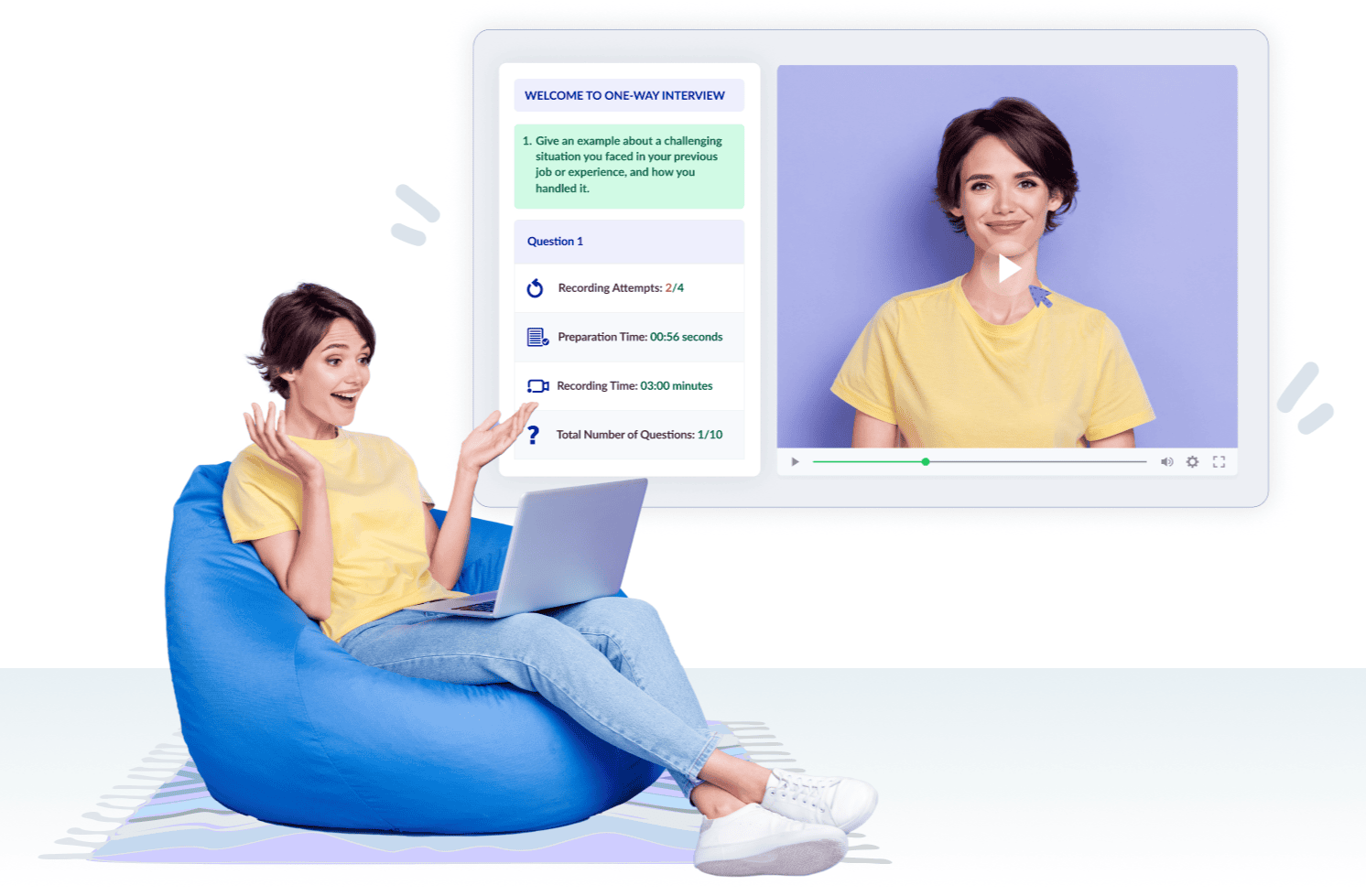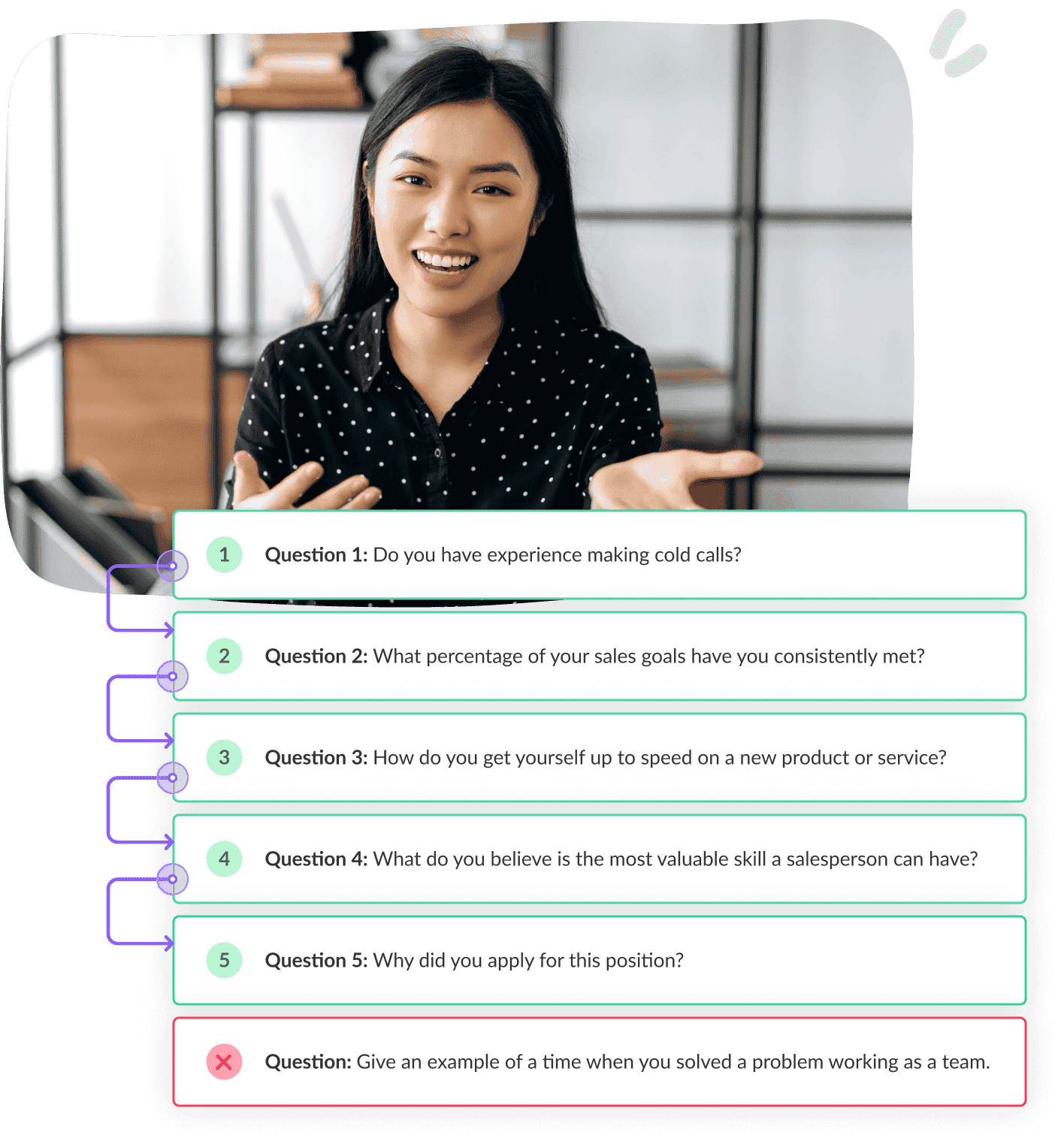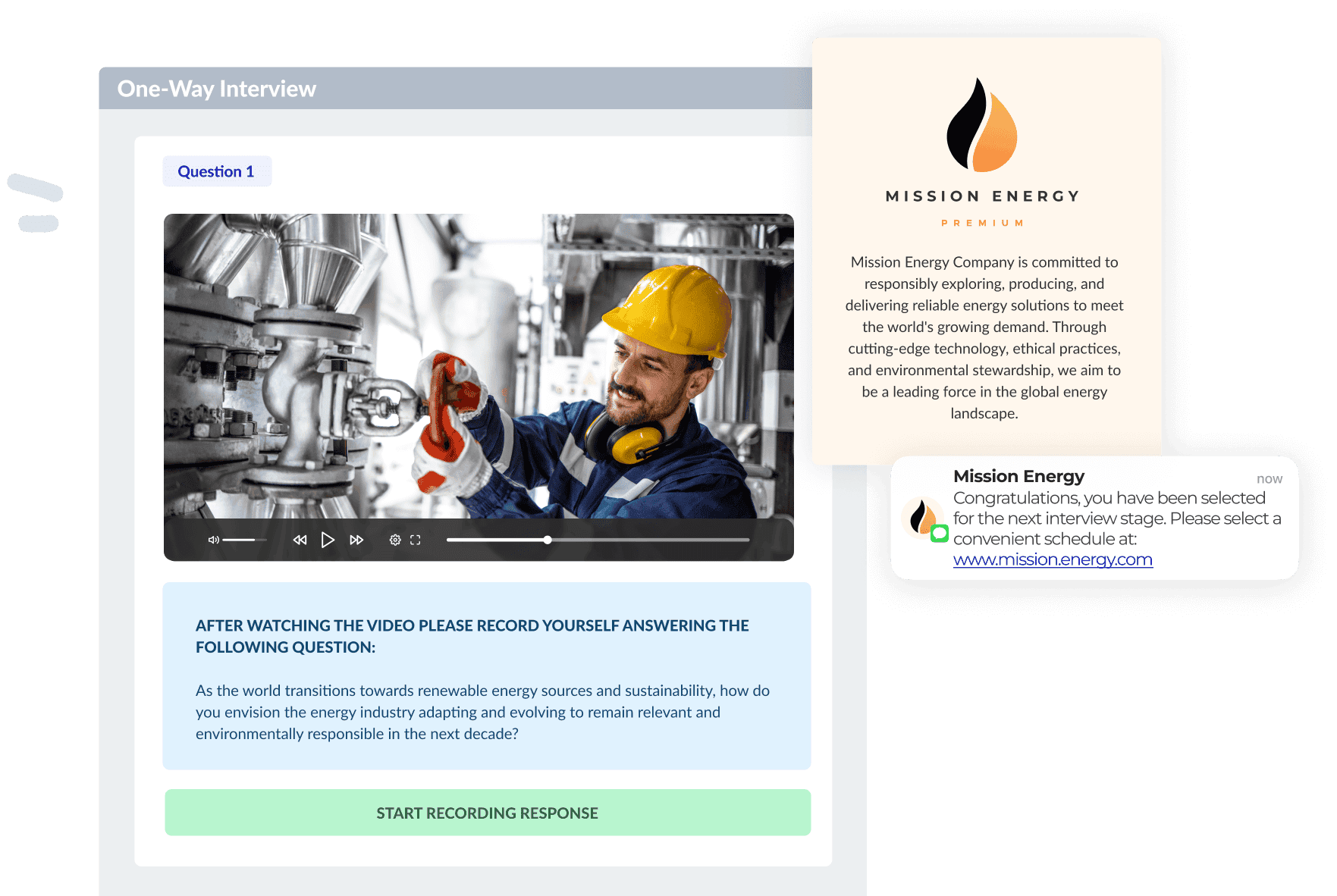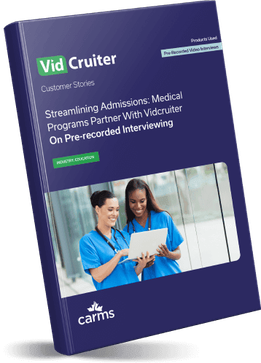
What is An Interview Guide?
Interviewers are now equipped with structured interviewing tools, including processes, procedures, and best practices. Our interview guide makes all the difference!

One-way interviews are a type of video interview software where the candidates record answers to interview questions and raters independently evaluate the answers at a later time. When used instead of screening interviews, they can streamline the hiring process while offering flexibility for both candidates and recruiters.
Ready to impress as a candidate in one-way interviews?
Maximize your success in one-way interviews. Discover essential tips and strategies in our comprehensive guide: How to Ace Your Video Interview.
A one-way interview is a structured interview that invites candidates to record short video responses to pre-set interview questions on any device. Unlike a live interview, there is no interviewer present.
A hiring manager or recruiter reviews and rates the applicants’ video submissions asynchronously using an interview scorecard.
One-way interviews are also called pre-recorded video interviews, on-demand interviews, self-paced interviews, or asynchronous interviews.

Interview Setup: Before the process, the recruiting team sets up the interview on a digital platform, choosing the number and order of questions to be asked, preparation time limits, response time limits, and whether candidates can review or re-record their responses before submitting them.
Candidate Participation: The candidates receive an invitation to access the interview and are given a deadline for submission. They can choose to record and submit their responses at any time before the deadline.
Response Recording: Candidates are shown the questions one at a time. If the process allows, candidates may have the ability to re-record answers multiple times before submitting them. This format helps some candidates by reducing the stress of on-the-spot answering.
Submission and Review: Once candidates submit their videos, the hiring team can review responses at their convenience. This asynchronous approach allows for more flexibility in the scheduling process and can allow some hiring teams to screen a larger applicant pool.
Evaluation and Scoring: Raters use an interview scorecard to assess the candidates' responses. Some processes may even include multiple raters to get a more thorough evaluation of a candidate at the screening stage. This structured approach can help in reducing biases and ensuring a fair evaluation process.
Decision Making: Based on the video responses and evaluations, the hiring team decides which candidates to move forward in the recruitment process.
During a screening call, sticking to the script, keeping the conversation on-topic, and staying neutral can be tough. On-demand interviewing simplifies screening so you can focus on assessing the candidate’s answers.
Reduce time-to-hire
Setting up the process once, and then reviewing and rating videos requires less time than conducting screening interviews.
Eliminate scheduling
No more scheduling phone screens. On-demand interviews free up time for other tasks and offer raters more flexibility.
Easily conduct structured interviews
Ask every applicant the same questions, in the same order, in the same way.
Accommodate remote candidates
Eliminate time zone hassles with on-demand interviewing and expand your candidate pool.
Simplify collaboration
Multiple raters can review, rate, and collectively decide on a candidate's progress remotely.
Minimize hiring bias
Built-in interview guides standardize and streamline the process, leading to better interview compliance.
Automate repetitive tasks
Reduce manual tasks like candidate communication with automated reminders and notifications.
Build a talent pool
If a company has multiple job openings, different hiring managers can evaluate a candidate without re-interviewing.
Allow raters to replay answers
Avoid relying on memory. Review interviews as many times as needed to ensure accurate ratings.
On-demand interviews can help you offer a positive candidate experience to keep job seekers engaged throughout the hiring process.
Offer flexibility and convenience
Candidates complete the interview where and when is ideal for them, so they can balance their job search with their other commitments.
Save time and money on travel-related costs
Remove barriers for candidates who don’t have the time or resources to attend every stage of the interview process in person.
Create an opportunity to showcase skills
On-demand interviews offer preparation time and resubmissions, allowing candidates to showcase their strengths with less stress.
Keep candidates up-to-date
Automated candidate communication protocols allow you to maintain effective communication with applicants at every step.
To ensure the most effective use of one-way interviews, it's crucial to focus on two types of questions: knockout questions and those that help qualify the candidate’s experience, skills, and fit for the role.
Knockout questions are designed to immediately identify candidates who do not meet the essential criteria for the position. In addition to knockout questions, quickly explore whether the candidate's experience and qualifications are aligned to the role. These questions help draw out specific examples of past work and accomplishments that are directly relevant to the role.
Interview questions that assess person-organization fit are vital. These questions help determine if the candidate is not only capable of performing the job, but also a good fit for the company's strategic objectives and ethos. If you use this strategy, you’ll be able to curate an optimized question set to help improve your quality of hire.

Top tip for further improving one-way interview questions
Get input on your questions from industrial and organizational psychologists and diversity, equity, and inclusion specialists. These professionals can refine interview questions to mitigate bias, ensure validity, and enhance inclusivity and fairness in the hiring process.
Using video-based questions in addition to text-based questions sets clear expectations about your corporate culture and expresses your brand’s personality. It is a great way to make the interview process feel more personalized and interesting for applicants.
Adding a message from upper management or a genuine testimonial from an employee allows your organization to showcase the job and work environment.
The importance of employer brand
According to Dayforce, a well-defined employer brand online and throughout the hiring process can help your organization attract top talent.
of people would consider changing jobs to work at a company with an excellent corporate reputation
of HR professionals surveyed said recruitment is becoming more like marketing
of active job seekers are likely to apply for a job if the employer actively manages its employer brand
Interview software allows full customization: prep time, questions, length of responses, and if applicants can re-record their answers. Test your interview to make sure the instructions make sense and if you’re setting realistic time expectations based on the types of questions you’re asking.
Study reports from your interviewing system to see what you can learn from them. They often include detailed descriptions of the status of each candidate, individual activity logs, the candidate’s rating compared to others, and more. Use this data to gauge progress and improve your process.
One-way interviews are still debated despite their widespread adoption. There are many myths surrounding video interviews. Speak to the facts since there are many ways to implement one-way interviews.
Fact: Some argue that a self-paced interview can introduce appearance biases. In actuality, self-paced interviews mitigate some of the biases that adversely affect diversity-identified groups. If your process is properly structured and your raters are trained correctly, a candidate’s video setup should not affect the ratings.
By standardizing the questions and interview scorecards, keeping them competency-focused, and removing the interviewer, everyone is treated with greater equity.
Fact: Asynchronous interviews promote inclusion and accessibility. They can help widen the candidate pool by eliminating resource, geographic, and scheduling barriers for some.
These interviews can be tailored for greater accessibility through features like re-recording options and adjustable preparation times.
The technology behind pre-recorded interviews integrates seamlessly with existing accessibility tools, further facilitating an inclusive recruitment process.
Fact: While on-demand interviews remove the opportunity to interact with someone from the organization during initial screening, there’s no need to rely on recruiters to make a great first impression with candidates.
Here are some ways to create a positive candidate experience using on-demand screening:

Applicant attitudes toward asynchronous interviews
How do asynchronous interviews compare to other screening selection techniques from candidates’ perspective?
A Frontiers study found that pre-conceived ideas about video interviewing (as well as individual characteristics and traits) impact how people feel about pre-recorded interviews.

AI interview software conducts one-way interviews, and then uses AI to evaluate candidates. This interview format is typically used to screen for entry-level positions or in high-volume hiring scenarios.
These interviews can be AI-led, where the AI scores interviews based on inputs and algorithms and advances candidates—or AI-influenced, where it provides ratings and recommendations.
There’s also human-led, AI-augmented interviewing (also known as interview intelligence) that assesses the interviewers, not the candidates. In this instance, AI is used to provide feedback on, and in turn—improve the process.
Get familiar with the structured process and how to use the software, read the digital interview guide, and step back and see this as an opportunity to go beyond just textual screening.
Recruiters and hiring managers conduct one-way interviews because they:

Enriching Medical Program Evaluations Using Pre-Recorded Interviewing
Discover the impact of pre-recorded interviewing as an evaluation tools for admissions. Find out how pre-recorded interviewing can increase the number of applicants you can interview, and elevate the quality of evaluations, while also guaranteeing fairness and inclusivity for all candidates.
By providing email address, you agree to receive
updates from VidCruiter.
Read our
Privacy Policy
Modernize your hiring process with expert insights and advice.